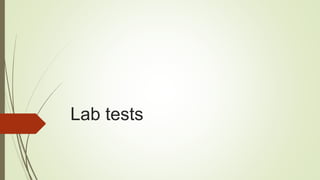This document provides information about various components of a complete blood count (CBC) test, including white blood cell (WBC), red blood cell (RBC), and platelet counts. It describes what each test measures, its normal reference ranges, potential abnormal findings and their implications. Nursing considerations are outlined for preparing patients for CBC testing and interpreting results. The document also discusses the blood urea nitrogen (BUN) test and how it is used to evaluate kidney function. In summary, it reviews several common blood tests, what they indicate about a patient's health, and nursing responsibilities related to ordering and following up on the tests.





































































































